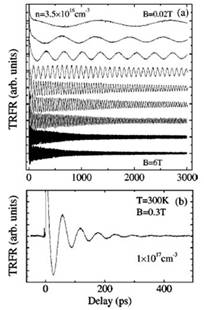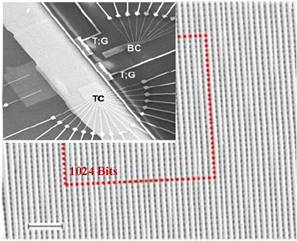 Prof. Ezekiel Johnston-Halperin is new to Ohio State, having joined the Condensed Matter Experiment group within the Department of Physics in July of 2006. Previous to arriving at OSU he received his graduate training in physics at the University of California at Santa Barbara in the lab of Prof. David Awschalom and worked as a post-doctoral researcher at the California Institute of Technology in the lab of Prof. James Heath in the Division of Chemistry and Chemical Engineering.
Prof. Ezekiel Johnston-Halperin is new to Ohio State, having joined the Condensed Matter Experiment group within the Department of Physics in July of 2006. Previous to arriving at OSU he received his graduate training in physics at the University of California at Santa Barbara in the lab of Prof. David Awschalom and worked as a post-doctoral researcher at the California Institute of Technology in the lab of Prof. James Heath in the Division of Chemistry and Chemical Engineering.
Dr. Johnston-Halperin’s research history covers a broad range of topics in spin-based and nanoscale science and technology, including:
- ultrafast spin dynamics in III-V semiconductors,
- epitaxial growth of ferromagnetic (Ga,Mn)As and subsequent spintronic device design and fabrication,
- fabrication of nanowire-based circuits at the unprecedented density of 0.5 TBit/in2, and
- investigation of functional molecular materials as nanoscale electronic building blocks.
Examples of Recent Research
Figure 1 (below) shows how the ability to fabricate extremely dense crossbar arrays coupled with the use of bistable molecular materials with scale-invariant functionality enables the fabrication of electronically addressable memory circuits at densities comparable to or better than the latest magnetic memory technologies.
A second example can be found in Figure 2 (below): due to its weak spin orbit coupling, GaN exhibits spin coherence times comparable to the highest quality GaAs epilayers, with significant coherence present even at room temperature. This result has significant implications for the design of functional spintronic circuits as well as in the pursuit of solid-state based quantum computing.
Current Research Activities
Since arriving at OSU, Prof. Johnston-Halperin has begun an interdisciplinary and collaborative research effort aimed at both the development of functional nanostructured materials as well as exploring ways to integrate spin-based functionality into nanoscale devices. Prof. Johnston-Halperin’s research group currently consists of two graduate student researchers (Sarah Parks and Lei Fang, both from the Department of Physics), and is still in the process of expanding. Current and pending research projects include:
- The nanoscale patterning of magnetic thin films, using techniques similar to those seen in Fig. 2 and in collaboration with Prof. Fengyuan Yang in the Department of Physics. These structures are of potential interest for magnetic random-access memory (MRAM) and in the fabrication of magnetic meta-materials.
- The investigation of spin-transport in hybrid molecular/ solid-state systems in collaboration with Prof. Malcolm Chisholm in the Department of Chemistry and Prof. Jonathan Pelz in the Department of Physics.
- The epitaxial synthesis of both magnetic and non-magnetic nanowires using metal-organic chemical vapor deposition in collaboration with the Wright Center for Photovoltaics Innovation and Commercialization (PVIC) at OSU.
More information and recent results can be found on the Johnston-Halperin group website.

Fig. 1 (a) Time resolved Faraday rotation signal (TRFR) from a GaN epilayer at various magnetic fields. The oscillating signal tracks the x-component of the optically induced spin polarization; the envelope of this signal indicates the inhomogenous (T2*) spin lifetime. (b) TRFR data showing room-temperature spin coherence PRB(Rapid Comm.) 63, 121202 (2001).

Fig. 2 Inset: Large area view of a nanowire-based crossbar circuit including lithographically defined electrical contacts. Main Image: Expanded view of a nanowire crossbar at a bit density of 10 11 Bits/cm 2. A bistable 2 rotaxane molecular monolayer forms the functional layer of the device – publication pending, Nature.
